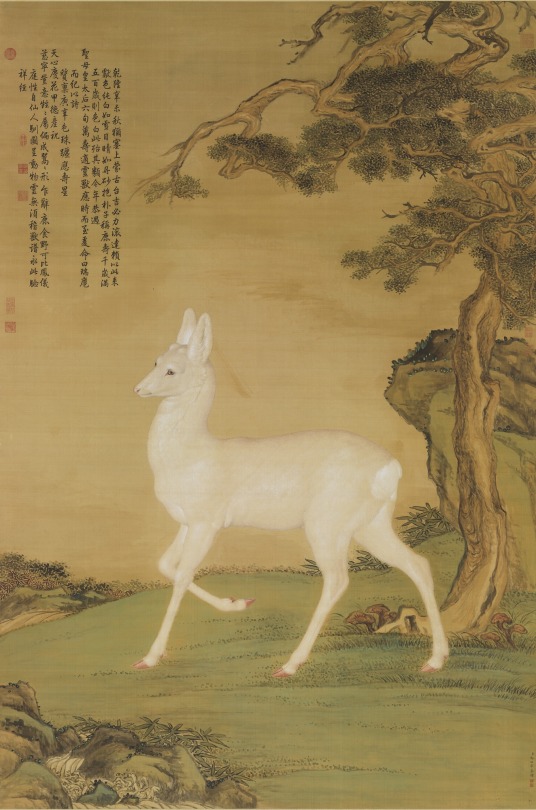#hanging scroll
Explore tagged Tumblr posts
Text

MWW Artwork of the Day (10/12/24) Zhu Zhanji (Emperor Xuanzong)(Chinese, 1399-1435) Three Yang [Goats], an Auspicious Start (to the New Year)(1429) Hanging scroll, ink & colors on paper, 211.6 x 142.5 cm. National Palace Museum, Taipei
In this ink painting with light colors from the fourth year of Xuanzong's reign (1429) are a ewe and two lambs with a background of bamboo, rocks, and camellias. The subject of three goats is a homophone for "Three Yang, an Auspicious Start to the New Year." This title comes from the Book of Changes, which consists of 64 hexagram (six-line) combinations of trigrams (three-line symbols). The eleventh hexagram translates literally as "Earth (and) Heavens (at) Peace" and is represented by the symbol. With the three lines of qian (yang) below and three of kun (yin) above unified and harmoniously connected, it symbolizes peace throughout the heavens and earth.
7 notes
·
View notes
Text
カケジク

掛け軸は、日本伝統の美術工芸品の一つで、絵画や書などを長方形の布や紙に描き、巻物のように巻いて収納できるようにしたものです。一般的に、木製の軸に巻いて飾ることから「掛け軸」と呼ばれています。 掛け軸は、その用途によって様々な種類があります。仏画や尊像を描いたものは仏事や法要などで使われ、書や日本画などは季節や祝い事などに合わせて飾られます。また、掛け軸は部屋の装飾品としても使われ、部屋の雰囲気や季節感を演出する役割も果たしています。 掛け軸は、その制作に様々な技術や工夫が凝らされています。絵画や書を描くだけでなく、絵や文字を囲む装飾的な枠線や、絵の余白を埋める余白絵(よはえ)、絵や書を引き立てるような模様や色合いの布や紙の選択など、総合芸術的な要素も持っています。
手抜きイラスト集
#掛け軸#hanging scroll#rotolo sospeso#pergamino colgante#hängende Schriftrolle#parchemin suspendu#手抜きイラスト#Japonais#bearbench#art#artwork#illustration#painting
0 notes
Text

"Possession of the Shamaness Tajihi no Ayako (多治比文子) by the Spirit of Sugawara no Michizane (菅原道真)" a detail from "Illustrated Legends of the Kitano Tenjin Shrine" (北野天神縁起絵巻) dating to 1300 or so.
"Posesi��n de la chamana Tajihi no Ayako (多治比文子) por el espíritu de Sugawara no Michizane (菅原道真)", un detalle de "Leyendas ilustradas del santuario Kitano Tenjin" (北野天神縁起絵巻) que data de 1300 aproximadamente
Handscroll fragment mounted as hanging scroll: ink on paper from the collection of the Metropolitan Museum of Art in New York
#japanese art#arte japonés#絵巻#emaki#hanging scroll#pergamino colgante#北野天神縁起絵巻#kitano tenjin engi emaki
10 notes
·
View notes
Text

Landscape in the Style of Fan Kuan
Metropolitan Museum of Art Terms and Conditions
#early 12th century#Hanging scroll#ink and color on silk#Scroll paintings#Scrolls#Paintings#Metropolitan Museum of Art#Asia#China#Ink#Silk#Hanging scrolls#art#old#Chinese
1 note
·
View note
Video
20240113 Ensyu area 8 by Bong Grit Via Flickr: 移動して豊田佐吉記念館。復元された生家の床の間には秋葉神社の掛け軸。 @Sakichi Toyoda Memorial Museum, Kosai city, Shizuoka pref.(静岡県湖西市 豊田佐吉記念館)
#Japanese house#Hanging scroll#Akiba Shrine#Shinto shrine#Shinto#Shrine#Toyota Motor Corporation#Sakichi Toyoda Memorial Museum#Sakichi Toyoda#Toyoda Sakichi#Kosai#Shizuoka#Japan#Nikon#Nikon D850#COSINA#COSINA Voigtländer NOKTON 58mm F1.4 SL2 N#flickr
5 notes
·
View notes
Text

Katsushika Hokusai, Woman Looking at Herself in a Mirror, ca. 1805, pigment/silk (Museum of Fine Arts, Boston)
11 notes
·
View notes
Text
Lofi hip hop beats to study to.

0 notes
Text

Auspicious Roe Deer
Giuseppe Castiglione
hanging scroll, ink and colors on silk, after 1751
41 notes
·
View notes
Text

Detail: Taizokai (womb realm) Mandala, silk hanging scroll, Shingon tantric buddhist school, Heian period (794-1185), Tō-ji, Kyōto, Japan. Japanese National Treasure
9th century
#hanging scroll#japan#detail#mandala#japanese painting#9th century#japanese national treasure#scroll#art history#aesthetictumblr#tumblraesthetic#tumblrpic#japanese art#tumblrpictures#tumblr art#tumblrstyle#artists on tumblr#tumblrposts#aesthetic#asian art#japanese aesthetic#asian aesthetic
4 notes
·
View notes
Text
Chaekgado - Hanging Scroll


#chaekgado#watercolor#joseon dynasty#artwork#hanging scroll#korean folk painting#korean painting#south korea
1 note
·
View note
Photo

Hanging scroll of a Standing Beauty in a Dance Pose, mid 1600s, Japan.
23 notes
·
View notes
Text

A painted image of the Thirteen Buddhas, a set of deities invoked on behalf of the deceased during the sequence of memorial services from the seventh day after to the thirty-third year after
Hanging scroll, silk with pigment and gold dating to the later years of the Muromachi period (1336-1573)
28 notes
·
View notes
Text
So, as I understand it, traditionally if a kimono’s obi in the front, that symbolized that the wearer was a sex worker (why tie it back up if you just were going to take it off again soon?) which causes me to ask a few questions about the hanging scroll.

#Phoenix wright: trials and tribulations#hanging scroll#Misty fey#like no judgement#im very sex worker positive#it just gives me something else to consider#queue takumi defense squad
6 notes
·
View notes
Photo

Plum Blossoms and Moon by Umemoto Shôkei (Edo Period)
#umemoto shokei#art#paintings#hanging scroll#fine art#19th century#19th century art#edo era#edo period#painting#japanese#japanese art#nature art#plum blossom#plum tree#moon#full moon#asian art#classic art
329 notes
·
View notes
Photo

MWW Artwork of the Day (7/9/22) Attributed to Katsushika Hokusai (Japanese, 1760–1849) Gamecocks (1838) Hanging scroll; ink and color on silk, 54.9 x 84.8 cm. The Metropolitan Museum of Art, New York (Charles Stewart Smith Collection)
The bantam cock on the right aggressively faces off with his companion to the left as it eyes us, the viewers, as if to ask whether it should engage in battle. In the trademark fashion of Hokusai animal paintings, the expressions of the birds convey humanlike emotions. Their plumage is meticulously rendered, suggesting a deluxe commission. From ancient times in Japan, gamecocks (Japanese: shamo) were specifically bred as fighting birds.
1 note
·
View note
